HR4038 HRM in Practice Essay: Contemporary HRM Debates Analysis
VerifiedAdded on 2022/08/26
|12
|2892
|17
Essay
AI Summary
This essay explores contemporary debates within Human Resource Management (HRM), addressing key topics such as employer branding, organizational culture, job design, employee engagement, the role of line managers, and international HRM. The essay delves into the dynamics of employer branding and recruitment, emphasizing the importance of organizational culture in attracting and retaining talent. It examines job design's impact on motivation and the significance of employee engagement. Additionally, it discusses the line manager's role in HRM, the challenges of international HRM, and emerging issues in the field. The essay also provides a case study analysis of Unilever's HRM practices, highlighting its organizational culture, sustainability initiatives, and strategies for employee engagement. The essay draws on recent academic literature and provides a comprehensive overview of the critical debates and practices shaping the HRM landscape.
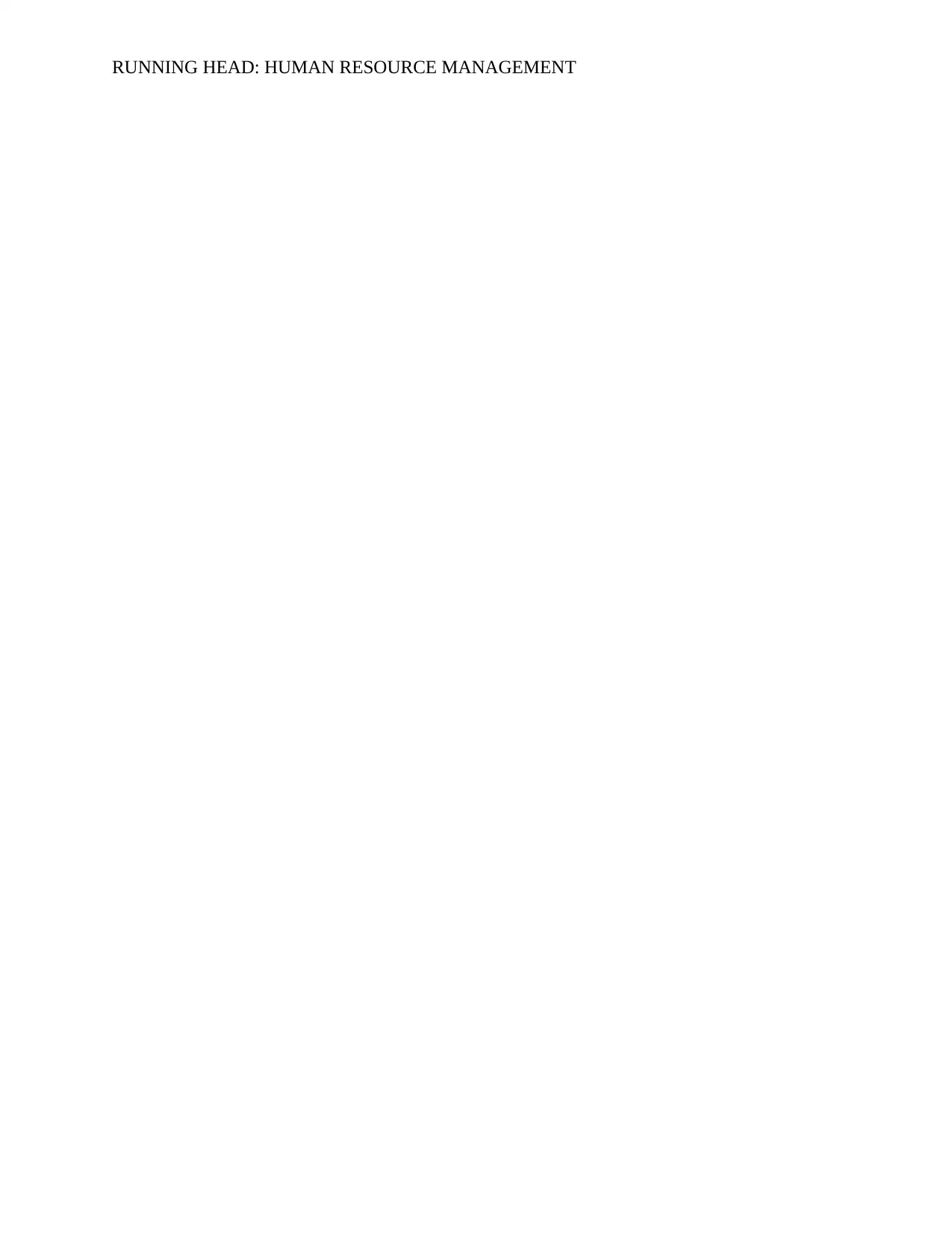
RUNNING HEAD: HUMAN RESOURCE MANAGEMENT
Paraphrase This Document
Need a fresh take? Get an instant paraphrase of this document with our AI Paraphraser
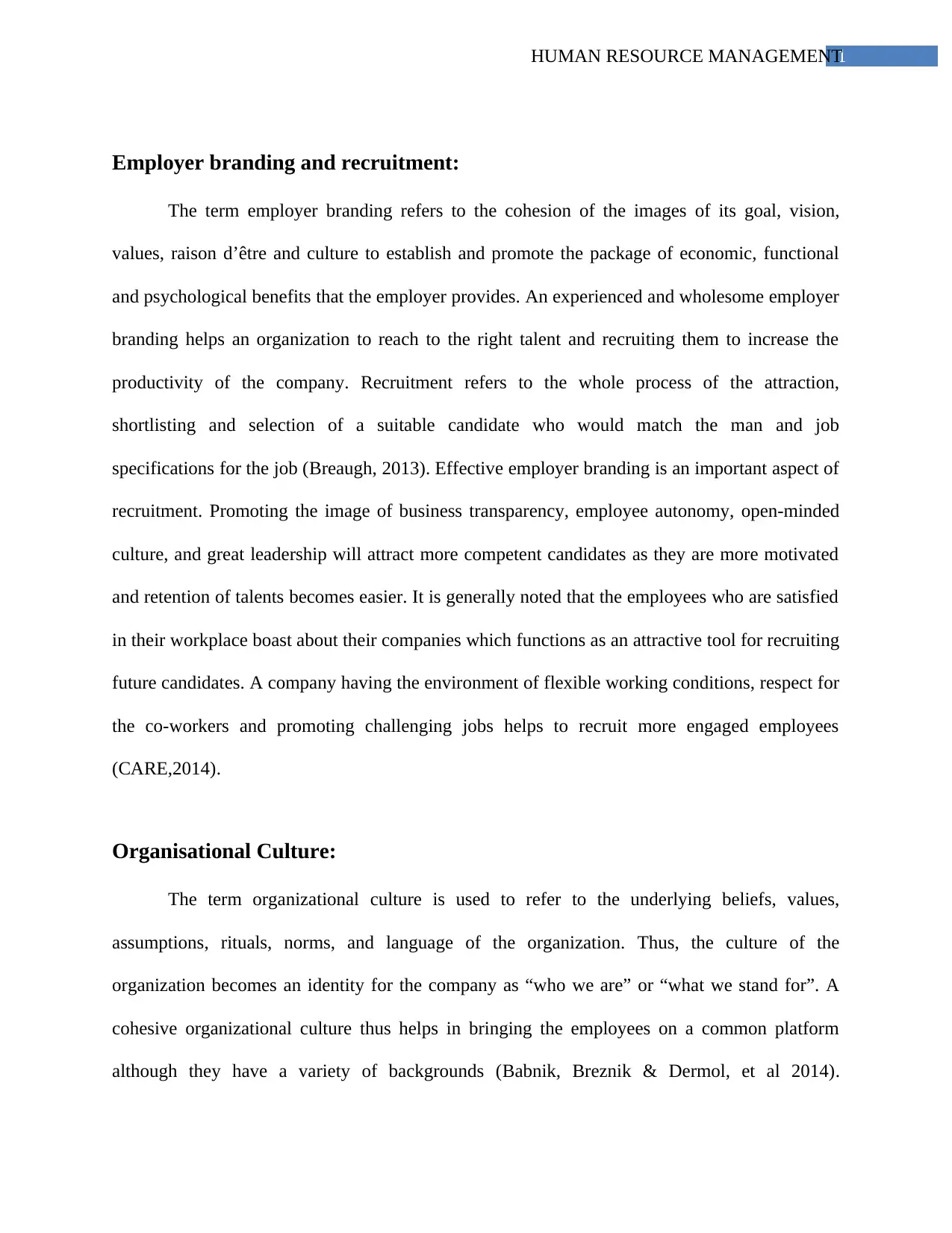
1HUMAN RESOURCE MANAGEMENT
Employer branding and recruitment:
The term employer branding refers to the cohesion of the images of its goal, vision,
values, raison d’être and culture to establish and promote the package of economic, functional
and psychological benefits that the employer provides. An experienced and wholesome employer
branding helps an organization to reach to the right talent and recruiting them to increase the
productivity of the company. Recruitment refers to the whole process of the attraction,
shortlisting and selection of a suitable candidate who would match the man and job
specifications for the job (Breaugh, 2013). Effective employer branding is an important aspect of
recruitment. Promoting the image of business transparency, employee autonomy, open-minded
culture, and great leadership will attract more competent candidates as they are more motivated
and retention of talents becomes easier. It is generally noted that the employees who are satisfied
in their workplace boast about their companies which functions as an attractive tool for recruiting
future candidates. A company having the environment of flexible working conditions, respect for
the co-workers and promoting challenging jobs helps to recruit more engaged employees
(CARE,2014).
Organisational Culture:
The term organizational culture is used to refer to the underlying beliefs, values,
assumptions, rituals, norms, and language of the organization. Thus, the culture of the
organization becomes an identity for the company as “who we are” or “what we stand for”. A
cohesive organizational culture thus helps in bringing the employees on a common platform
although they have a variety of backgrounds (Babnik, Breznik & Dermol, et al 2014).
Employer branding and recruitment:
The term employer branding refers to the cohesion of the images of its goal, vision,
values, raison d’être and culture to establish and promote the package of economic, functional
and psychological benefits that the employer provides. An experienced and wholesome employer
branding helps an organization to reach to the right talent and recruiting them to increase the
productivity of the company. Recruitment refers to the whole process of the attraction,
shortlisting and selection of a suitable candidate who would match the man and job
specifications for the job (Breaugh, 2013). Effective employer branding is an important aspect of
recruitment. Promoting the image of business transparency, employee autonomy, open-minded
culture, and great leadership will attract more competent candidates as they are more motivated
and retention of talents becomes easier. It is generally noted that the employees who are satisfied
in their workplace boast about their companies which functions as an attractive tool for recruiting
future candidates. A company having the environment of flexible working conditions, respect for
the co-workers and promoting challenging jobs helps to recruit more engaged employees
(CARE,2014).
Organisational Culture:
The term organizational culture is used to refer to the underlying beliefs, values,
assumptions, rituals, norms, and language of the organization. Thus, the culture of the
organization becomes an identity for the company as “who we are” or “what we stand for”. A
cohesive organizational culture thus helps in bringing the employees on a common platform
although they have a variety of backgrounds (Babnik, Breznik & Dermol, et al 2014).
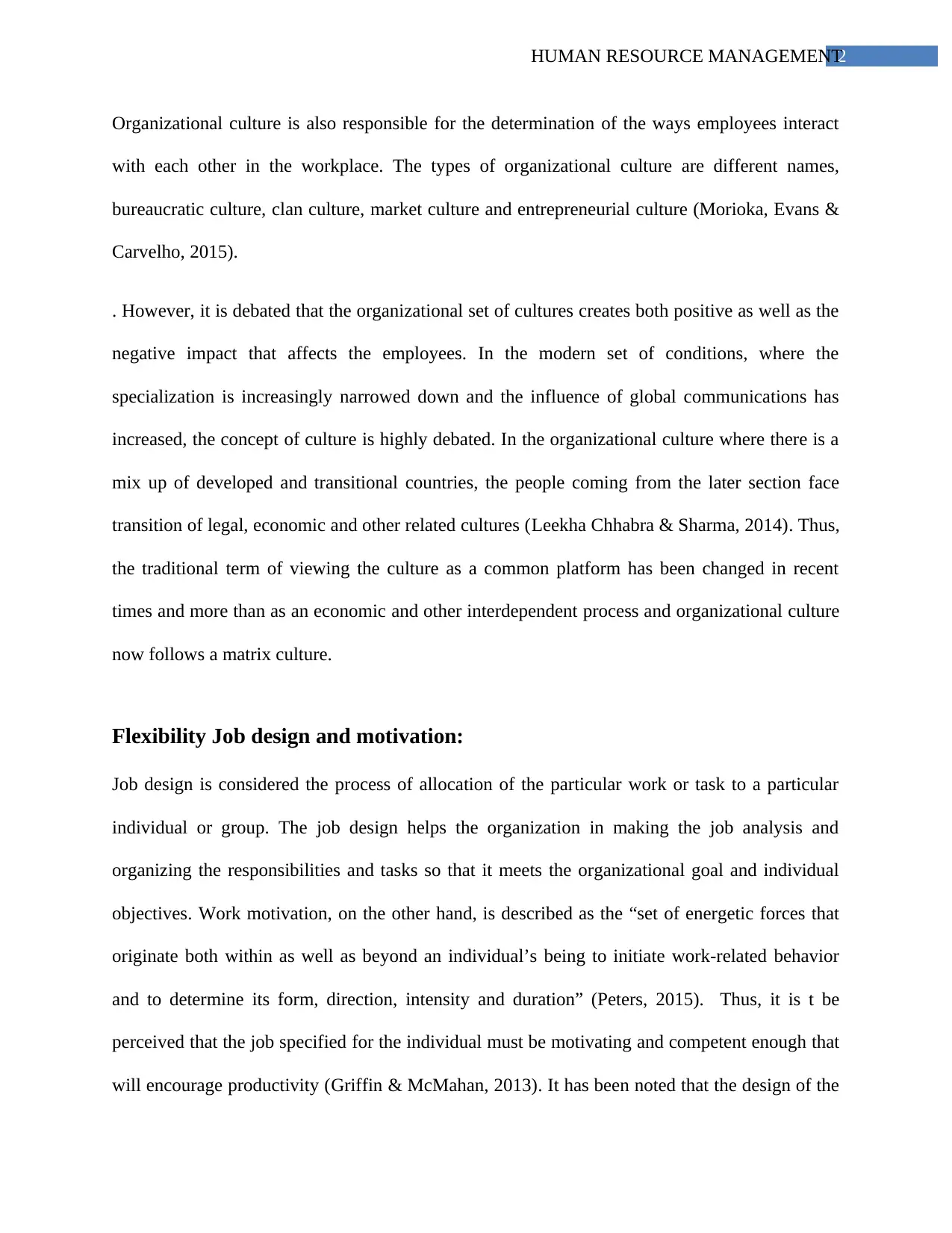
2HUMAN RESOURCE MANAGEMENT
Organizational culture is also responsible for the determination of the ways employees interact
with each other in the workplace. The types of organizational culture are different names,
bureaucratic culture, clan culture, market culture and entrepreneurial culture (Morioka, Evans &
Carvelho, 2015).
. However, it is debated that the organizational set of cultures creates both positive as well as the
negative impact that affects the employees. In the modern set of conditions, where the
specialization is increasingly narrowed down and the influence of global communications has
increased, the concept of culture is highly debated. In the organizational culture where there is a
mix up of developed and transitional countries, the people coming from the later section face
transition of legal, economic and other related cultures (Leekha Chhabra & Sharma, 2014). Thus,
the traditional term of viewing the culture as a common platform has been changed in recent
times and more than as an economic and other interdependent process and organizational culture
now follows a matrix culture.
Flexibility Job design and motivation:
Job design is considered the process of allocation of the particular work or task to a particular
individual or group. The job design helps the organization in making the job analysis and
organizing the responsibilities and tasks so that it meets the organizational goal and individual
objectives. Work motivation, on the other hand, is described as the “set of energetic forces that
originate both within as well as beyond an individual’s being to initiate work-related behavior
and to determine its form, direction, intensity and duration” (Peters, 2015). Thus, it is t be
perceived that the job specified for the individual must be motivating and competent enough that
will encourage productivity (Griffin & McMahan, 2013). It has been noted that the design of the
Organizational culture is also responsible for the determination of the ways employees interact
with each other in the workplace. The types of organizational culture are different names,
bureaucratic culture, clan culture, market culture and entrepreneurial culture (Morioka, Evans &
Carvelho, 2015).
. However, it is debated that the organizational set of cultures creates both positive as well as the
negative impact that affects the employees. In the modern set of conditions, where the
specialization is increasingly narrowed down and the influence of global communications has
increased, the concept of culture is highly debated. In the organizational culture where there is a
mix up of developed and transitional countries, the people coming from the later section face
transition of legal, economic and other related cultures (Leekha Chhabra & Sharma, 2014). Thus,
the traditional term of viewing the culture as a common platform has been changed in recent
times and more than as an economic and other interdependent process and organizational culture
now follows a matrix culture.
Flexibility Job design and motivation:
Job design is considered the process of allocation of the particular work or task to a particular
individual or group. The job design helps the organization in making the job analysis and
organizing the responsibilities and tasks so that it meets the organizational goal and individual
objectives. Work motivation, on the other hand, is described as the “set of energetic forces that
originate both within as well as beyond an individual’s being to initiate work-related behavior
and to determine its form, direction, intensity and duration” (Peters, 2015). Thus, it is t be
perceived that the job specified for the individual must be motivating and competent enough that
will encourage productivity (Griffin & McMahan, 2013). It has been noted that the design of the
⊘ This is a preview!⊘
Do you want full access?
Subscribe today to unlock all pages.

Trusted by 1+ million students worldwide
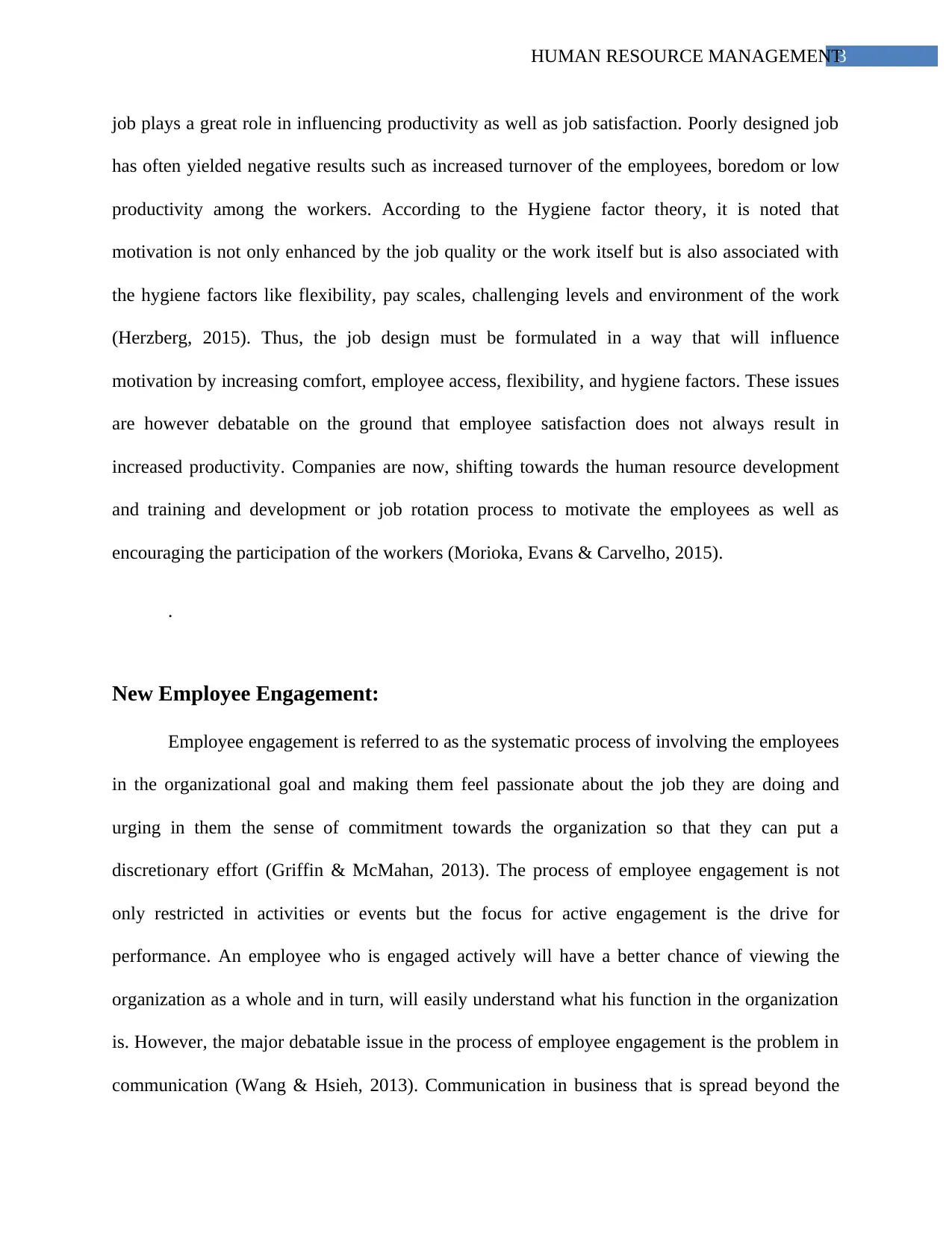
3HUMAN RESOURCE MANAGEMENT
job plays a great role in influencing productivity as well as job satisfaction. Poorly designed job
has often yielded negative results such as increased turnover of the employees, boredom or low
productivity among the workers. According to the Hygiene factor theory, it is noted that
motivation is not only enhanced by the job quality or the work itself but is also associated with
the hygiene factors like flexibility, pay scales, challenging levels and environment of the work
(Herzberg, 2015). Thus, the job design must be formulated in a way that will influence
motivation by increasing comfort, employee access, flexibility, and hygiene factors. These issues
are however debatable on the ground that employee satisfaction does not always result in
increased productivity. Companies are now, shifting towards the human resource development
and training and development or job rotation process to motivate the employees as well as
encouraging the participation of the workers (Morioka, Evans & Carvelho, 2015).
.
New Employee Engagement:
Employee engagement is referred to as the systematic process of involving the employees
in the organizational goal and making them feel passionate about the job they are doing and
urging in them the sense of commitment towards the organization so that they can put a
discretionary effort (Griffin & McMahan, 2013). The process of employee engagement is not
only restricted in activities or events but the focus for active engagement is the drive for
performance. An employee who is engaged actively will have a better chance of viewing the
organization as a whole and in turn, will easily understand what his function in the organization
is. However, the major debatable issue in the process of employee engagement is the problem in
communication (Wang & Hsieh, 2013). Communication in business that is spread beyond the
job plays a great role in influencing productivity as well as job satisfaction. Poorly designed job
has often yielded negative results such as increased turnover of the employees, boredom or low
productivity among the workers. According to the Hygiene factor theory, it is noted that
motivation is not only enhanced by the job quality or the work itself but is also associated with
the hygiene factors like flexibility, pay scales, challenging levels and environment of the work
(Herzberg, 2015). Thus, the job design must be formulated in a way that will influence
motivation by increasing comfort, employee access, flexibility, and hygiene factors. These issues
are however debatable on the ground that employee satisfaction does not always result in
increased productivity. Companies are now, shifting towards the human resource development
and training and development or job rotation process to motivate the employees as well as
encouraging the participation of the workers (Morioka, Evans & Carvelho, 2015).
.
New Employee Engagement:
Employee engagement is referred to as the systematic process of involving the employees
in the organizational goal and making them feel passionate about the job they are doing and
urging in them the sense of commitment towards the organization so that they can put a
discretionary effort (Griffin & McMahan, 2013). The process of employee engagement is not
only restricted in activities or events but the focus for active engagement is the drive for
performance. An employee who is engaged actively will have a better chance of viewing the
organization as a whole and in turn, will easily understand what his function in the organization
is. However, the major debatable issue in the process of employee engagement is the problem in
communication (Wang & Hsieh, 2013). Communication in business that is spread beyond the
Paraphrase This Document
Need a fresh take? Get an instant paraphrase of this document with our AI Paraphraser
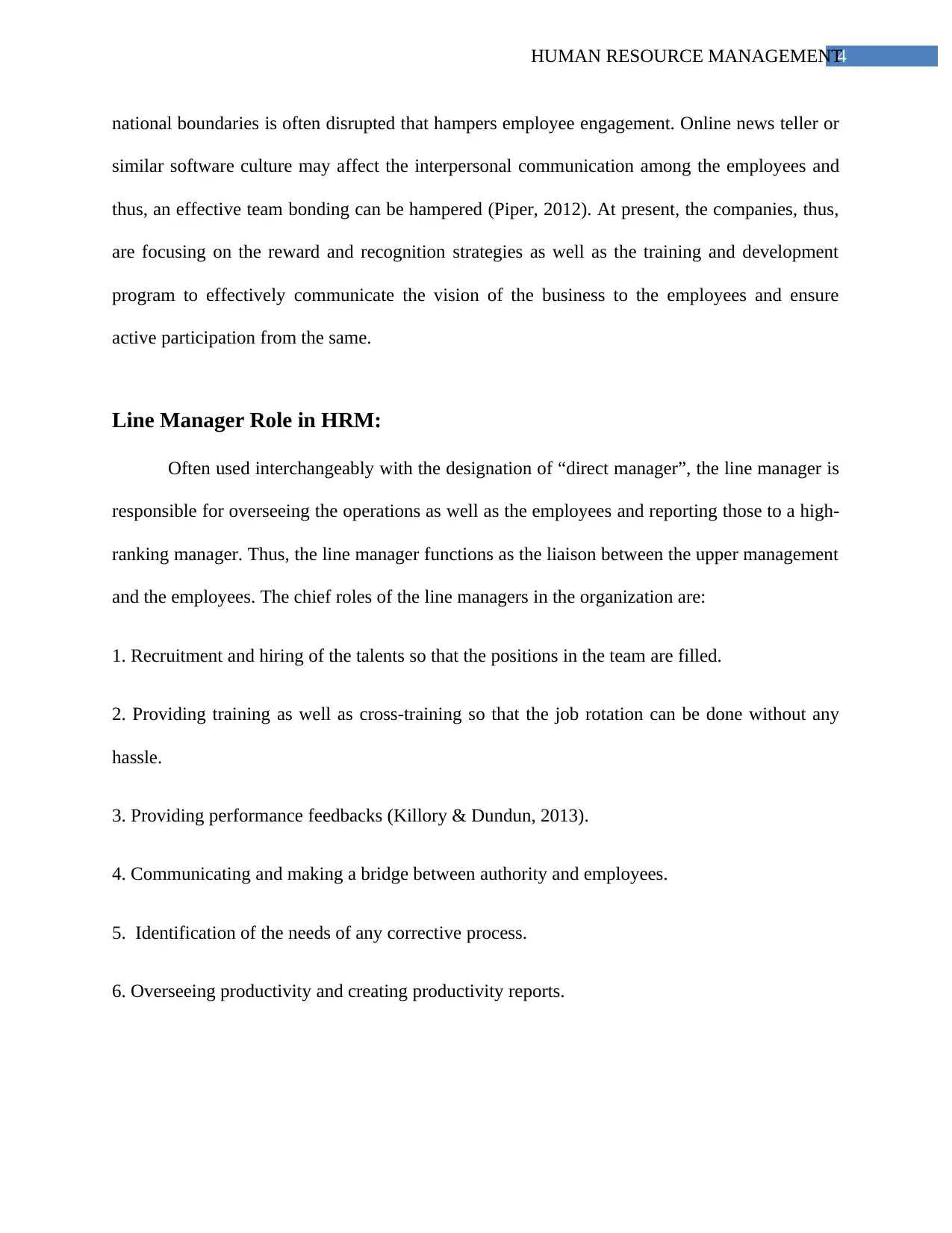
4HUMAN RESOURCE MANAGEMENT
national boundaries is often disrupted that hampers employee engagement. Online news teller or
similar software culture may affect the interpersonal communication among the employees and
thus, an effective team bonding can be hampered (Piper, 2012). At present, the companies, thus,
are focusing on the reward and recognition strategies as well as the training and development
program to effectively communicate the vision of the business to the employees and ensure
active participation from the same.
Line Manager Role in HRM:
Often used interchangeably with the designation of “direct manager”, the line manager is
responsible for overseeing the operations as well as the employees and reporting those to a high-
ranking manager. Thus, the line manager functions as the liaison between the upper management
and the employees. The chief roles of the line managers in the organization are:
1. Recruitment and hiring of the talents so that the positions in the team are filled.
2. Providing training as well as cross-training so that the job rotation can be done without any
hassle.
3. Providing performance feedbacks (Killory & Dundun, 2013).
4. Communicating and making a bridge between authority and employees.
5. Identification of the needs of any corrective process.
6. Overseeing productivity and creating productivity reports.
national boundaries is often disrupted that hampers employee engagement. Online news teller or
similar software culture may affect the interpersonal communication among the employees and
thus, an effective team bonding can be hampered (Piper, 2012). At present, the companies, thus,
are focusing on the reward and recognition strategies as well as the training and development
program to effectively communicate the vision of the business to the employees and ensure
active participation from the same.
Line Manager Role in HRM:
Often used interchangeably with the designation of “direct manager”, the line manager is
responsible for overseeing the operations as well as the employees and reporting those to a high-
ranking manager. Thus, the line manager functions as the liaison between the upper management
and the employees. The chief roles of the line managers in the organization are:
1. Recruitment and hiring of the talents so that the positions in the team are filled.
2. Providing training as well as cross-training so that the job rotation can be done without any
hassle.
3. Providing performance feedbacks (Killory & Dundun, 2013).
4. Communicating and making a bridge between authority and employees.
5. Identification of the needs of any corrective process.
6. Overseeing productivity and creating productivity reports.
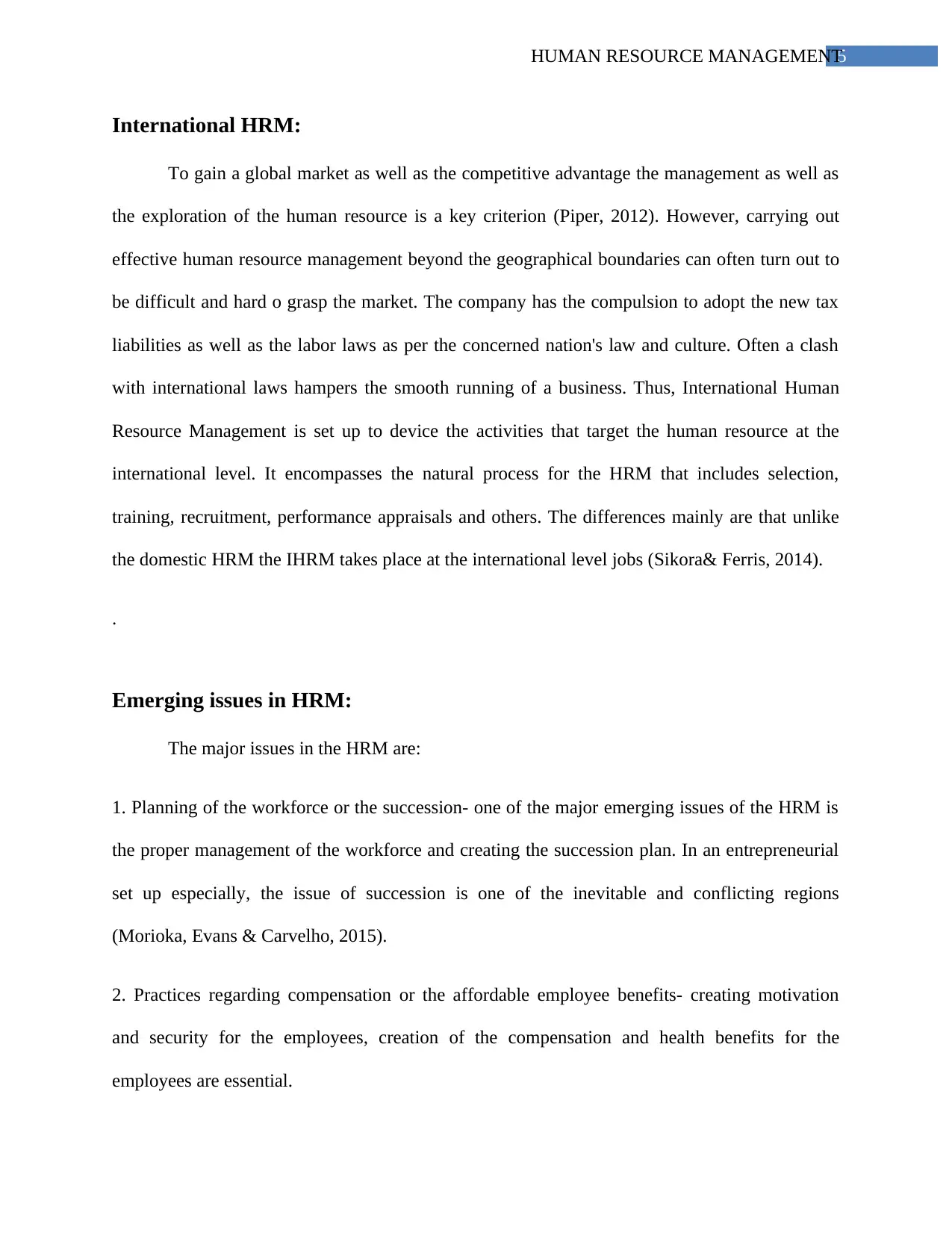
5HUMAN RESOURCE MANAGEMENT
International HRM:
To gain a global market as well as the competitive advantage the management as well as
the exploration of the human resource is a key criterion (Piper, 2012). However, carrying out
effective human resource management beyond the geographical boundaries can often turn out to
be difficult and hard o grasp the market. The company has the compulsion to adopt the new tax
liabilities as well as the labor laws as per the concerned nation's law and culture. Often a clash
with international laws hampers the smooth running of a business. Thus, International Human
Resource Management is set up to device the activities that target the human resource at the
international level. It encompasses the natural process for the HRM that includes selection,
training, recruitment, performance appraisals and others. The differences mainly are that unlike
the domestic HRM the IHRM takes place at the international level jobs (Sikora& Ferris, 2014).
.
Emerging issues in HRM:
The major issues in the HRM are:
1. Planning of the workforce or the succession- one of the major emerging issues of the HRM is
the proper management of the workforce and creating the succession plan. In an entrepreneurial
set up especially, the issue of succession is one of the inevitable and conflicting regions
(Morioka, Evans & Carvelho, 2015).
2. Practices regarding compensation or the affordable employee benefits- creating motivation
and security for the employees, creation of the compensation and health benefits for the
employees are essential.
International HRM:
To gain a global market as well as the competitive advantage the management as well as
the exploration of the human resource is a key criterion (Piper, 2012). However, carrying out
effective human resource management beyond the geographical boundaries can often turn out to
be difficult and hard o grasp the market. The company has the compulsion to adopt the new tax
liabilities as well as the labor laws as per the concerned nation's law and culture. Often a clash
with international laws hampers the smooth running of a business. Thus, International Human
Resource Management is set up to device the activities that target the human resource at the
international level. It encompasses the natural process for the HRM that includes selection,
training, recruitment, performance appraisals and others. The differences mainly are that unlike
the domestic HRM the IHRM takes place at the international level jobs (Sikora& Ferris, 2014).
.
Emerging issues in HRM:
The major issues in the HRM are:
1. Planning of the workforce or the succession- one of the major emerging issues of the HRM is
the proper management of the workforce and creating the succession plan. In an entrepreneurial
set up especially, the issue of succession is one of the inevitable and conflicting regions
(Morioka, Evans & Carvelho, 2015).
2. Practices regarding compensation or the affordable employee benefits- creating motivation
and security for the employees, creation of the compensation and health benefits for the
employees are essential.
⊘ This is a preview!⊘
Do you want full access?
Subscribe today to unlock all pages.

Trusted by 1+ million students worldwide
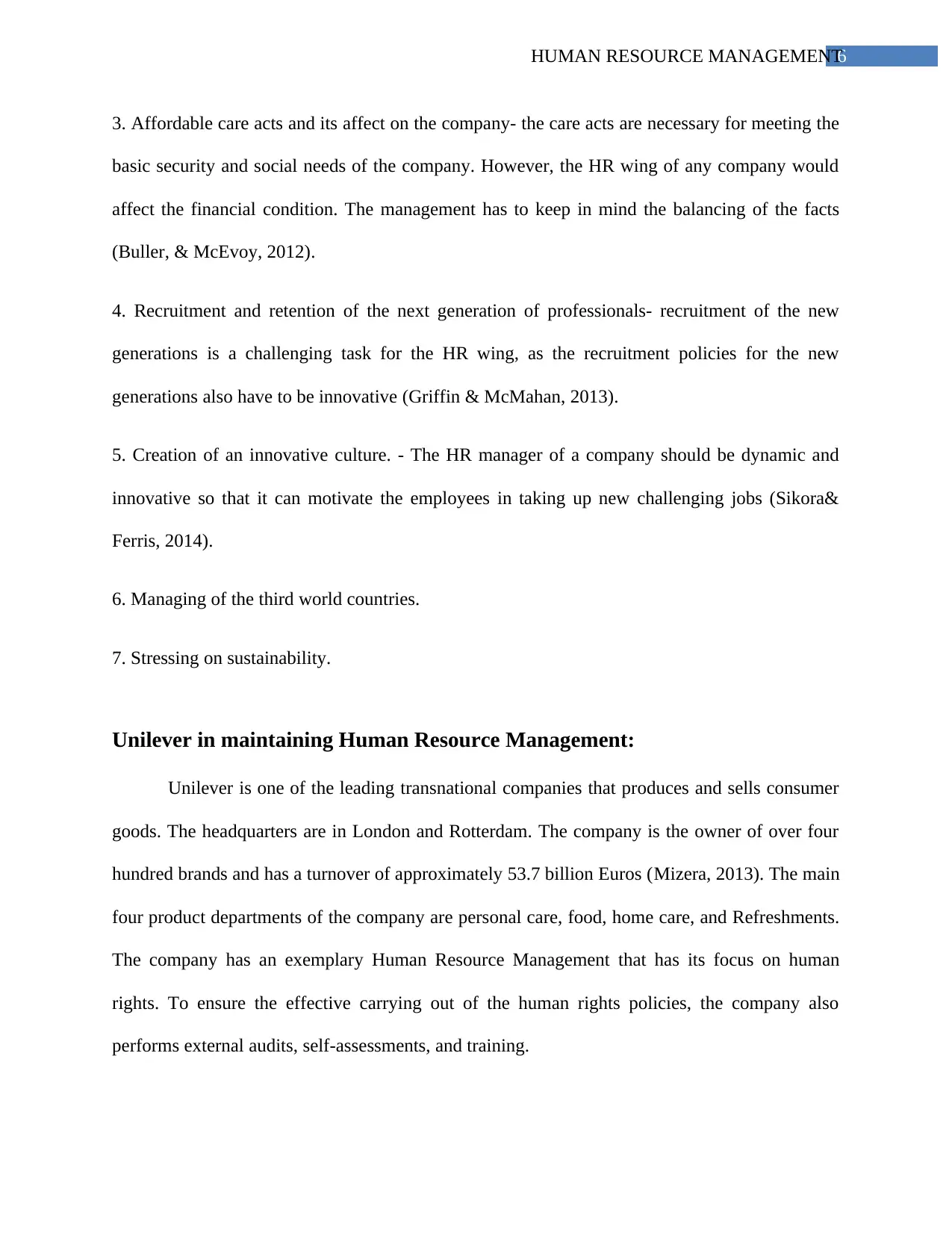
6HUMAN RESOURCE MANAGEMENT
3. Affordable care acts and its affect on the company- the care acts are necessary for meeting the
basic security and social needs of the company. However, the HR wing of any company would
affect the financial condition. The management has to keep in mind the balancing of the facts
(Buller, & McEvoy, 2012).
4. Recruitment and retention of the next generation of professionals- recruitment of the new
generations is a challenging task for the HR wing, as the recruitment policies for the new
generations also have to be innovative (Griffin & McMahan, 2013).
5. Creation of an innovative culture. - The HR manager of a company should be dynamic and
innovative so that it can motivate the employees in taking up new challenging jobs (Sikora&
Ferris, 2014).
6. Managing of the third world countries.
7. Stressing on sustainability.
Unilever in maintaining Human Resource Management:
Unilever is one of the leading transnational companies that produces and sells consumer
goods. The headquarters are in London and Rotterdam. The company is the owner of over four
hundred brands and has a turnover of approximately 53.7 billion Euros (Mizera, 2013). The main
four product departments of the company are personal care, food, home care, and Refreshments.
The company has an exemplary Human Resource Management that has its focus on human
rights. To ensure the effective carrying out of the human rights policies, the company also
performs external audits, self-assessments, and training.
3. Affordable care acts and its affect on the company- the care acts are necessary for meeting the
basic security and social needs of the company. However, the HR wing of any company would
affect the financial condition. The management has to keep in mind the balancing of the facts
(Buller, & McEvoy, 2012).
4. Recruitment and retention of the next generation of professionals- recruitment of the new
generations is a challenging task for the HR wing, as the recruitment policies for the new
generations also have to be innovative (Griffin & McMahan, 2013).
5. Creation of an innovative culture. - The HR manager of a company should be dynamic and
innovative so that it can motivate the employees in taking up new challenging jobs (Sikora&
Ferris, 2014).
6. Managing of the third world countries.
7. Stressing on sustainability.
Unilever in maintaining Human Resource Management:
Unilever is one of the leading transnational companies that produces and sells consumer
goods. The headquarters are in London and Rotterdam. The company is the owner of over four
hundred brands and has a turnover of approximately 53.7 billion Euros (Mizera, 2013). The main
four product departments of the company are personal care, food, home care, and Refreshments.
The company has an exemplary Human Resource Management that has its focus on human
rights. To ensure the effective carrying out of the human rights policies, the company also
performs external audits, self-assessments, and training.
Paraphrase This Document
Need a fresh take? Get an instant paraphrase of this document with our AI Paraphraser
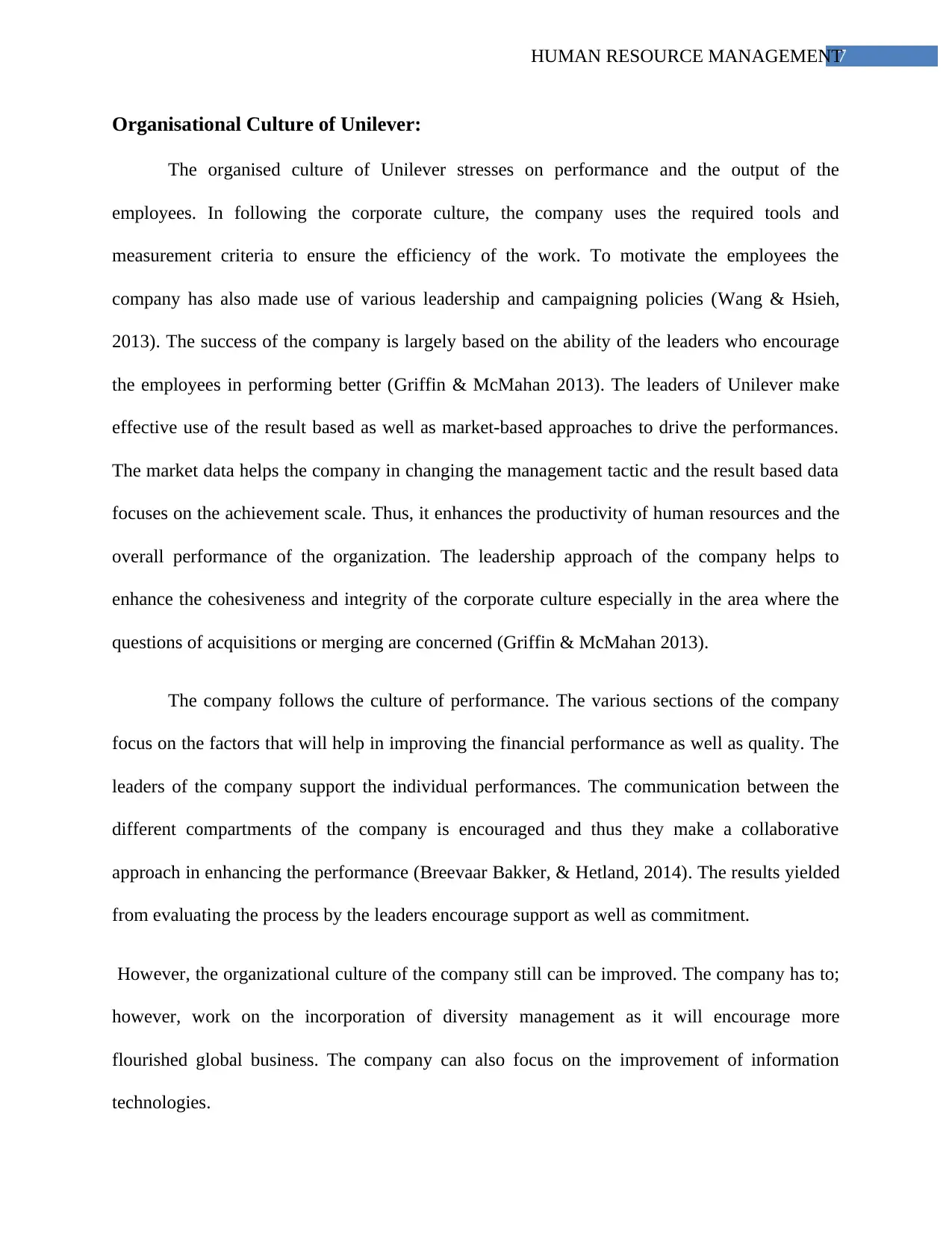
7HUMAN RESOURCE MANAGEMENT
Organisational Culture of Unilever:
The organised culture of Unilever stresses on performance and the output of the
employees. In following the corporate culture, the company uses the required tools and
measurement criteria to ensure the efficiency of the work. To motivate the employees the
company has also made use of various leadership and campaigning policies (Wang & Hsieh,
2013). The success of the company is largely based on the ability of the leaders who encourage
the employees in performing better (Griffin & McMahan 2013). The leaders of Unilever make
effective use of the result based as well as market-based approaches to drive the performances.
The market data helps the company in changing the management tactic and the result based data
focuses on the achievement scale. Thus, it enhances the productivity of human resources and the
overall performance of the organization. The leadership approach of the company helps to
enhance the cohesiveness and integrity of the corporate culture especially in the area where the
questions of acquisitions or merging are concerned (Griffin & McMahan 2013).
The company follows the culture of performance. The various sections of the company
focus on the factors that will help in improving the financial performance as well as quality. The
leaders of the company support the individual performances. The communication between the
different compartments of the company is encouraged and thus they make a collaborative
approach in enhancing the performance (Breevaar Bakker, & Hetland, 2014). The results yielded
from evaluating the process by the leaders encourage support as well as commitment.
However, the organizational culture of the company still can be improved. The company has to;
however, work on the incorporation of diversity management as it will encourage more
flourished global business. The company can also focus on the improvement of information
technologies.
Organisational Culture of Unilever:
The organised culture of Unilever stresses on performance and the output of the
employees. In following the corporate culture, the company uses the required tools and
measurement criteria to ensure the efficiency of the work. To motivate the employees the
company has also made use of various leadership and campaigning policies (Wang & Hsieh,
2013). The success of the company is largely based on the ability of the leaders who encourage
the employees in performing better (Griffin & McMahan 2013). The leaders of Unilever make
effective use of the result based as well as market-based approaches to drive the performances.
The market data helps the company in changing the management tactic and the result based data
focuses on the achievement scale. Thus, it enhances the productivity of human resources and the
overall performance of the organization. The leadership approach of the company helps to
enhance the cohesiveness and integrity of the corporate culture especially in the area where the
questions of acquisitions or merging are concerned (Griffin & McMahan 2013).
The company follows the culture of performance. The various sections of the company
focus on the factors that will help in improving the financial performance as well as quality. The
leaders of the company support the individual performances. The communication between the
different compartments of the company is encouraged and thus they make a collaborative
approach in enhancing the performance (Breevaar Bakker, & Hetland, 2014). The results yielded
from evaluating the process by the leaders encourage support as well as commitment.
However, the organizational culture of the company still can be improved. The company has to;
however, work on the incorporation of diversity management as it will encourage more
flourished global business. The company can also focus on the improvement of information
technologies.
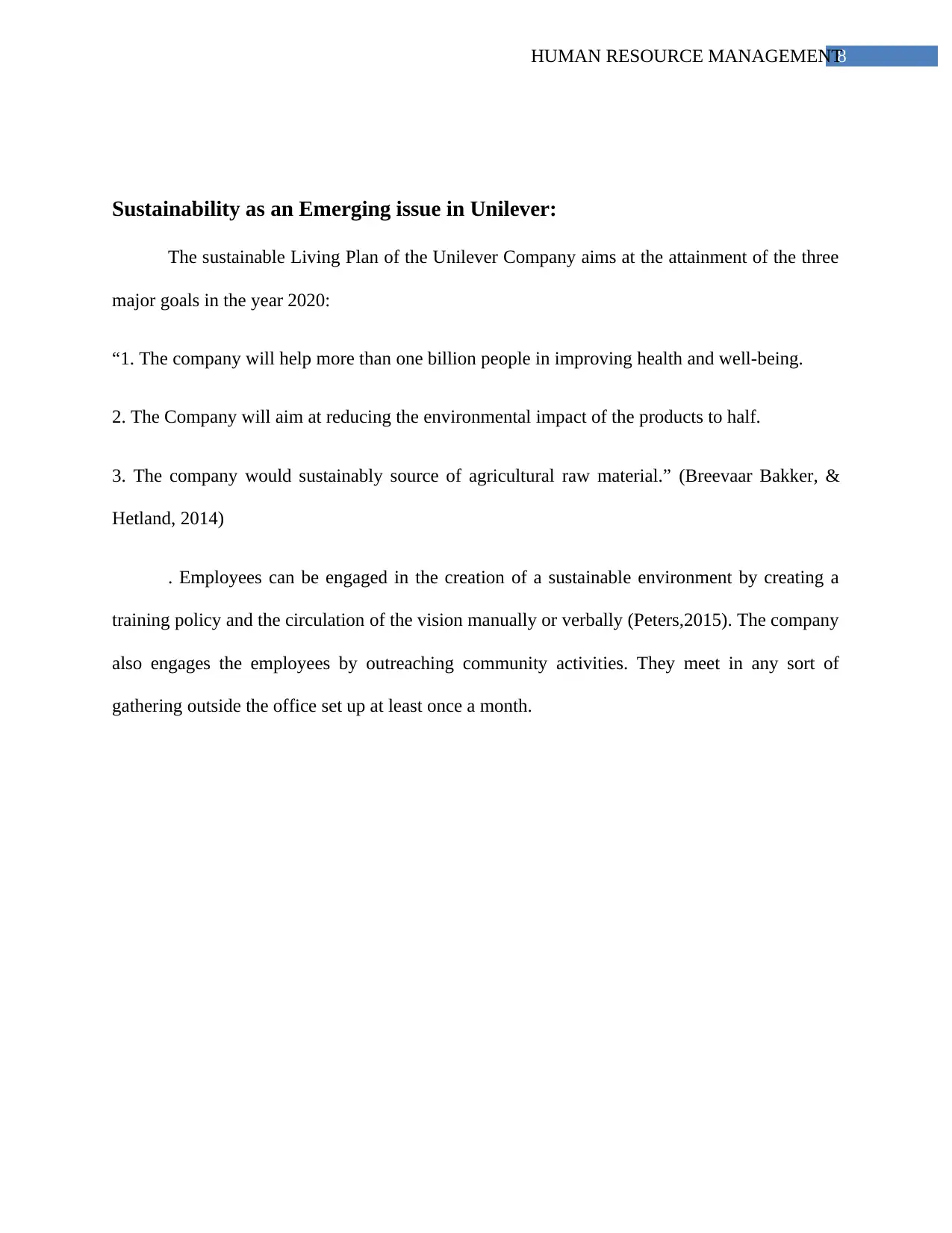
8HUMAN RESOURCE MANAGEMENT
Sustainability as an Emerging issue in Unilever:
The sustainable Living Plan of the Unilever Company aims at the attainment of the three
major goals in the year 2020:
“1. The company will help more than one billion people in improving health and well-being.
2. The Company will aim at reducing the environmental impact of the products to half.
3. The company would sustainably source of agricultural raw material.” (Breevaar Bakker, &
Hetland, 2014)
. Employees can be engaged in the creation of a sustainable environment by creating a
training policy and the circulation of the vision manually or verbally (Peters,2015). The company
also engages the employees by outreaching community activities. They meet in any sort of
gathering outside the office set up at least once a month.
Sustainability as an Emerging issue in Unilever:
The sustainable Living Plan of the Unilever Company aims at the attainment of the three
major goals in the year 2020:
“1. The company will help more than one billion people in improving health and well-being.
2. The Company will aim at reducing the environmental impact of the products to half.
3. The company would sustainably source of agricultural raw material.” (Breevaar Bakker, &
Hetland, 2014)
. Employees can be engaged in the creation of a sustainable environment by creating a
training policy and the circulation of the vision manually or verbally (Peters,2015). The company
also engages the employees by outreaching community activities. They meet in any sort of
gathering outside the office set up at least once a month.
⊘ This is a preview!⊘
Do you want full access?
Subscribe today to unlock all pages.

Trusted by 1+ million students worldwide
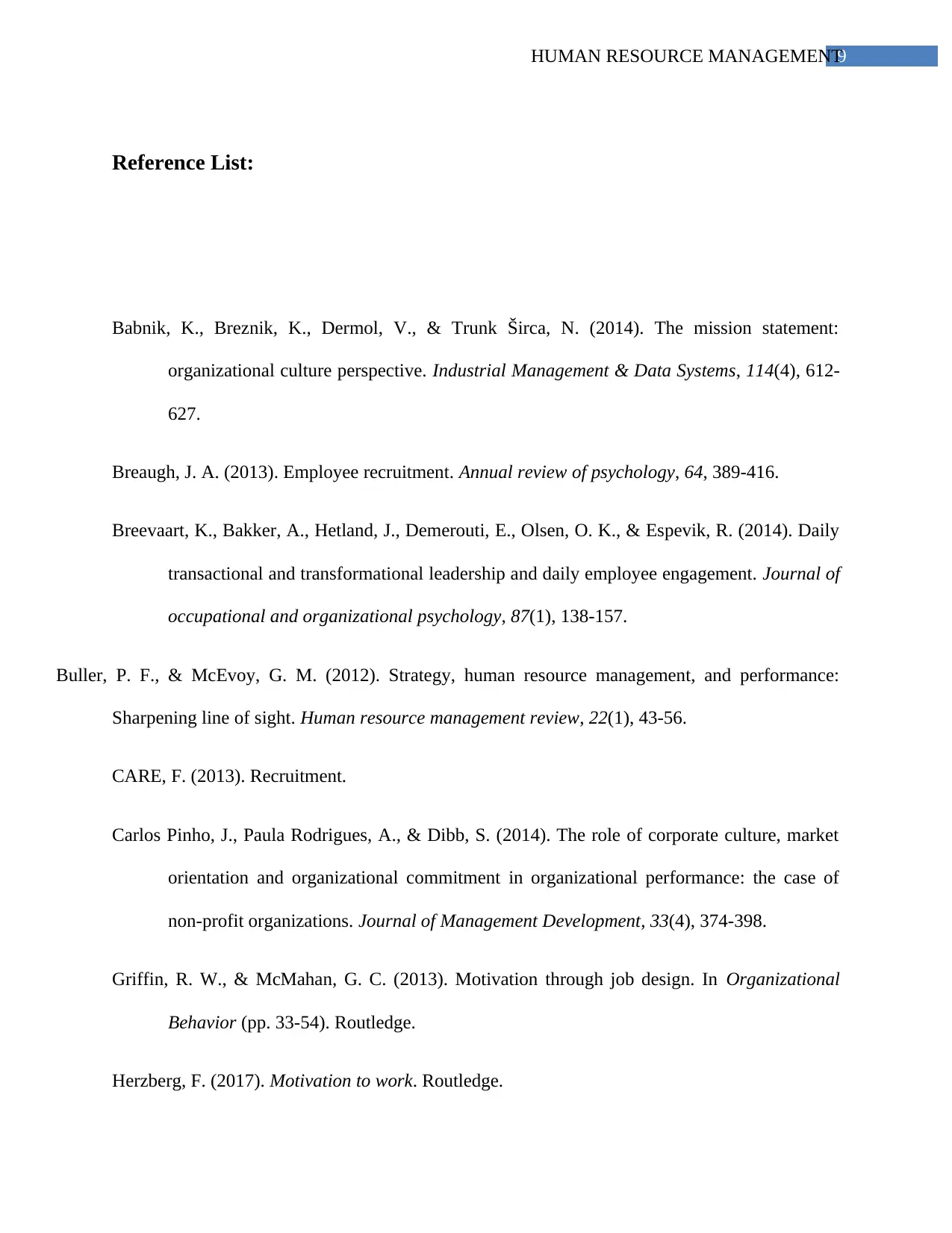
9HUMAN RESOURCE MANAGEMENT
Reference List:
Babnik, K., Breznik, K., Dermol, V., & Trunk Širca, N. (2014). The mission statement:
organizational culture perspective. Industrial Management & Data Systems, 114(4), 612-
627.
Breaugh, J. A. (2013). Employee recruitment. Annual review of psychology, 64, 389-416.
Breevaart, K., Bakker, A., Hetland, J., Demerouti, E., Olsen, O. K., & Espevik, R. (2014). Daily
transactional and transformational leadership and daily employee engagement. Journal of
occupational and organizational psychology, 87(1), 138-157.
Buller, P. F., & McEvoy, G. M. (2012). Strategy, human resource management, and performance:
Sharpening line of sight. Human resource management review, 22(1), 43-56.
CARE, F. (2013). Recruitment.
Carlos Pinho, J., Paula Rodrigues, A., & Dibb, S. (2014). The role of corporate culture, market
orientation and organizational commitment in organizational performance: the case of
non-profit organizations. Journal of Management Development, 33(4), 374-398.
Griffin, R. W., & McMahan, G. C. (2013). Motivation through job design. In Organizational
Behavior (pp. 33-54). Routledge.
Herzberg, F. (2017). Motivation to work. Routledge.
Reference List:
Babnik, K., Breznik, K., Dermol, V., & Trunk Širca, N. (2014). The mission statement:
organizational culture perspective. Industrial Management & Data Systems, 114(4), 612-
627.
Breaugh, J. A. (2013). Employee recruitment. Annual review of psychology, 64, 389-416.
Breevaart, K., Bakker, A., Hetland, J., Demerouti, E., Olsen, O. K., & Espevik, R. (2014). Daily
transactional and transformational leadership and daily employee engagement. Journal of
occupational and organizational psychology, 87(1), 138-157.
Buller, P. F., & McEvoy, G. M. (2012). Strategy, human resource management, and performance:
Sharpening line of sight. Human resource management review, 22(1), 43-56.
CARE, F. (2013). Recruitment.
Carlos Pinho, J., Paula Rodrigues, A., & Dibb, S. (2014). The role of corporate culture, market
orientation and organizational commitment in organizational performance: the case of
non-profit organizations. Journal of Management Development, 33(4), 374-398.
Griffin, R. W., & McMahan, G. C. (2013). Motivation through job design. In Organizational
Behavior (pp. 33-54). Routledge.
Herzberg, F. (2017). Motivation to work. Routledge.
Paraphrase This Document
Need a fresh take? Get an instant paraphrase of this document with our AI Paraphraser
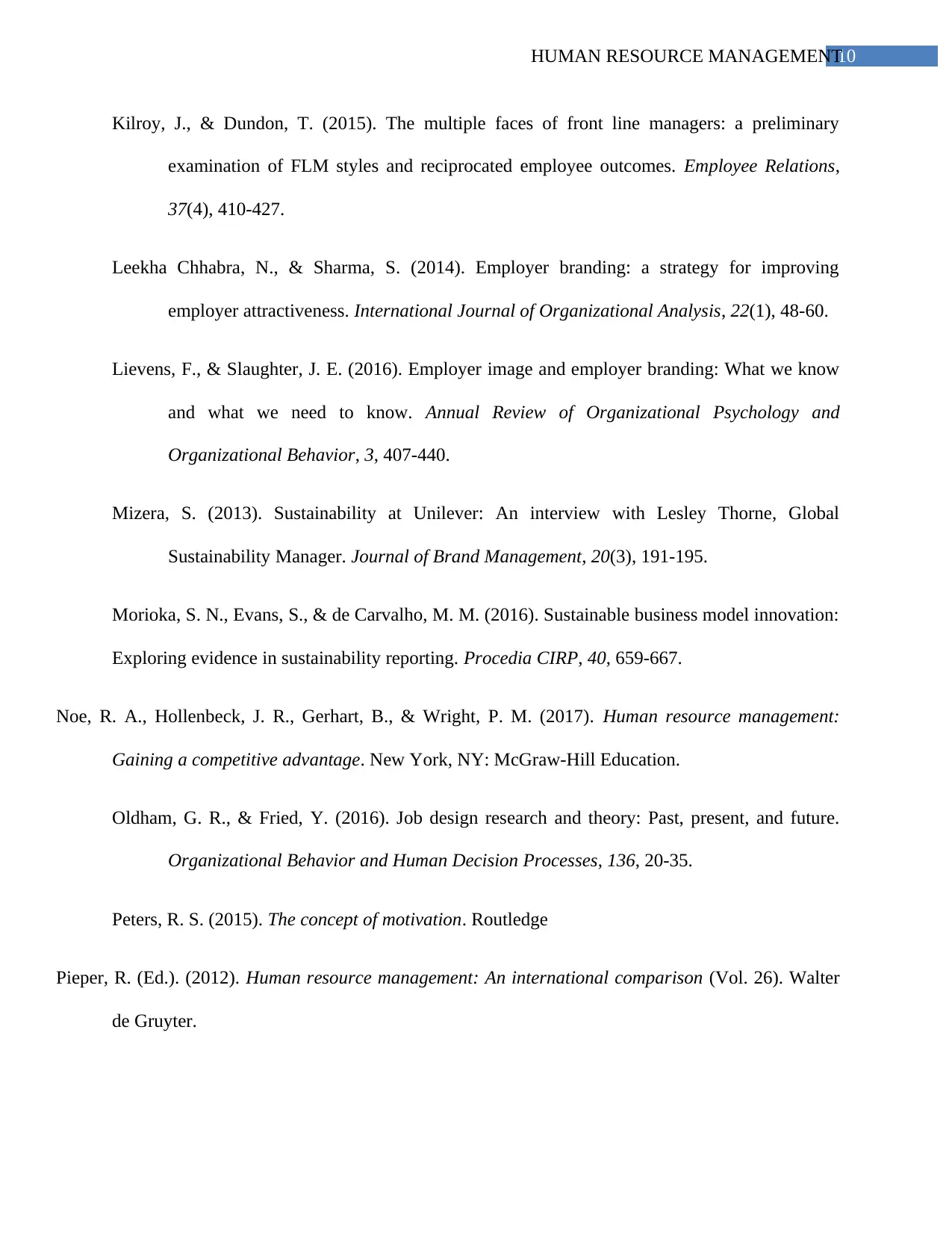
10HUMAN RESOURCE MANAGEMENT
Kilroy, J., & Dundon, T. (2015). The multiple faces of front line managers: a preliminary
examination of FLM styles and reciprocated employee outcomes. Employee Relations,
37(4), 410-427.
Leekha Chhabra, N., & Sharma, S. (2014). Employer branding: a strategy for improving
employer attractiveness. International Journal of Organizational Analysis, 22(1), 48-60.
Lievens, F., & Slaughter, J. E. (2016). Employer image and employer branding: What we know
and what we need to know. Annual Review of Organizational Psychology and
Organizational Behavior, 3, 407-440.
Mizera, S. (2013). Sustainability at Unilever: An interview with Lesley Thorne, Global
Sustainability Manager. Journal of Brand Management, 20(3), 191-195.
Morioka, S. N., Evans, S., & de Carvalho, M. M. (2016). Sustainable business model innovation:
Exploring evidence in sustainability reporting. Procedia CIRP, 40, 659-667.
Noe, R. A., Hollenbeck, J. R., Gerhart, B., & Wright, P. M. (2017). Human resource management:
Gaining a competitive advantage. New York, NY: McGraw-Hill Education.
Oldham, G. R., & Fried, Y. (2016). Job design research and theory: Past, present, and future.
Organizational Behavior and Human Decision Processes, 136, 20-35.
Peters, R. S. (2015). The concept of motivation. Routledge
Pieper, R. (Ed.). (2012). Human resource management: An international comparison (Vol. 26). Walter
de Gruyter.
Kilroy, J., & Dundon, T. (2015). The multiple faces of front line managers: a preliminary
examination of FLM styles and reciprocated employee outcomes. Employee Relations,
37(4), 410-427.
Leekha Chhabra, N., & Sharma, S. (2014). Employer branding: a strategy for improving
employer attractiveness. International Journal of Organizational Analysis, 22(1), 48-60.
Lievens, F., & Slaughter, J. E. (2016). Employer image and employer branding: What we know
and what we need to know. Annual Review of Organizational Psychology and
Organizational Behavior, 3, 407-440.
Mizera, S. (2013). Sustainability at Unilever: An interview with Lesley Thorne, Global
Sustainability Manager. Journal of Brand Management, 20(3), 191-195.
Morioka, S. N., Evans, S., & de Carvalho, M. M. (2016). Sustainable business model innovation:
Exploring evidence in sustainability reporting. Procedia CIRP, 40, 659-667.
Noe, R. A., Hollenbeck, J. R., Gerhart, B., & Wright, P. M. (2017). Human resource management:
Gaining a competitive advantage. New York, NY: McGraw-Hill Education.
Oldham, G. R., & Fried, Y. (2016). Job design research and theory: Past, present, and future.
Organizational Behavior and Human Decision Processes, 136, 20-35.
Peters, R. S. (2015). The concept of motivation. Routledge
Pieper, R. (Ed.). (2012). Human resource management: An international comparison (Vol. 26). Walter
de Gruyter.
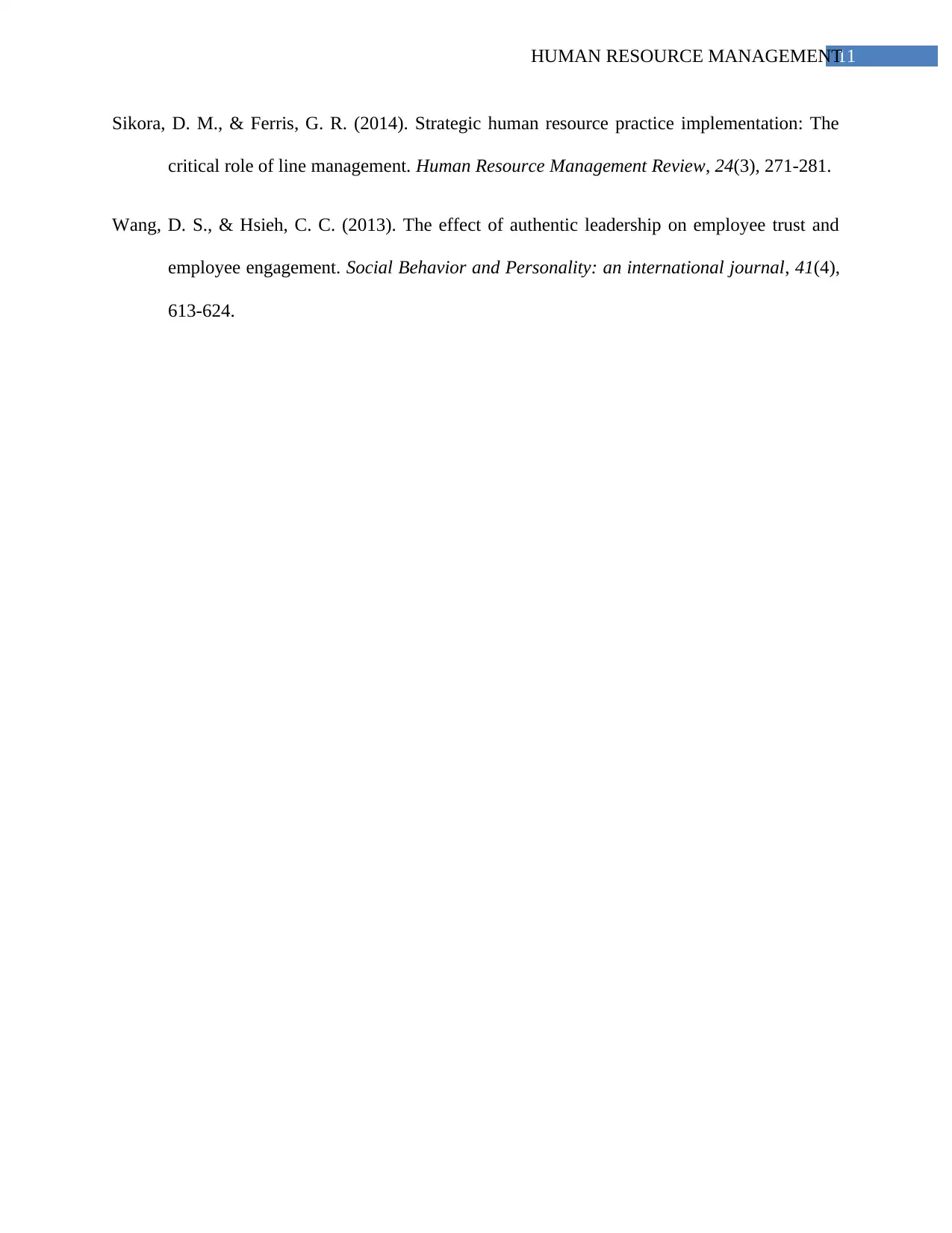
11HUMAN RESOURCE MANAGEMENT
Sikora, D. M., & Ferris, G. R. (2014). Strategic human resource practice implementation: The
critical role of line management. Human Resource Management Review, 24(3), 271-281.
Wang, D. S., & Hsieh, C. C. (2013). The effect of authentic leadership on employee trust and
employee engagement. Social Behavior and Personality: an international journal, 41(4),
613-624.
Sikora, D. M., & Ferris, G. R. (2014). Strategic human resource practice implementation: The
critical role of line management. Human Resource Management Review, 24(3), 271-281.
Wang, D. S., & Hsieh, C. C. (2013). The effect of authentic leadership on employee trust and
employee engagement. Social Behavior and Personality: an international journal, 41(4),
613-624.
⊘ This is a preview!⊘
Do you want full access?
Subscribe today to unlock all pages.

Trusted by 1+ million students worldwide
1 out of 12
Related Documents
Your All-in-One AI-Powered Toolkit for Academic Success.
+13062052269
info@desklib.com
Available 24*7 on WhatsApp / Email
![[object Object]](/_next/static/media/star-bottom.7253800d.svg)
Unlock your academic potential
Copyright © 2020–2025 A2Z Services. All Rights Reserved. Developed and managed by ZUCOL.





